Tube amps are special. I know there’s a lot of debate around whether they’re worth it or better than other types of amps. But they’re held in such high regard by guitarists for a reason.
And so if you’re not that familiar with tube amps and don’t understand the hype or what they do this guide is for you. I’m going to take you through how they work, their pros and cons, why guitarists are crazy about them and more.
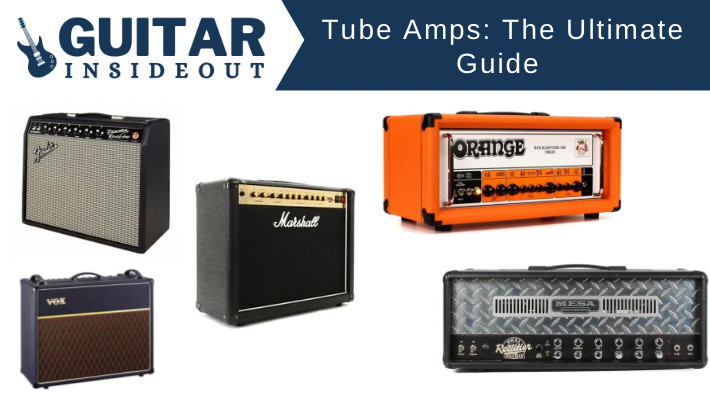
You’ll find out why tube amps are favored over solid-state and modeling options and we’ll get into tube amps use within different music genres. And hopefully I’ll help you decide if a tube amp is the right fit for you.
So let’s get started.
What is a Tube Amp
Let’s start at the beginning. A tube amp, short for “vacuum tube amplifier,” is an electronic amplifier. It amplifies the signal from an electric guitar and uses the vacuum tubes, or valves as they’re often known, to boost the signal to a level that drives a speaker which then produces sound.
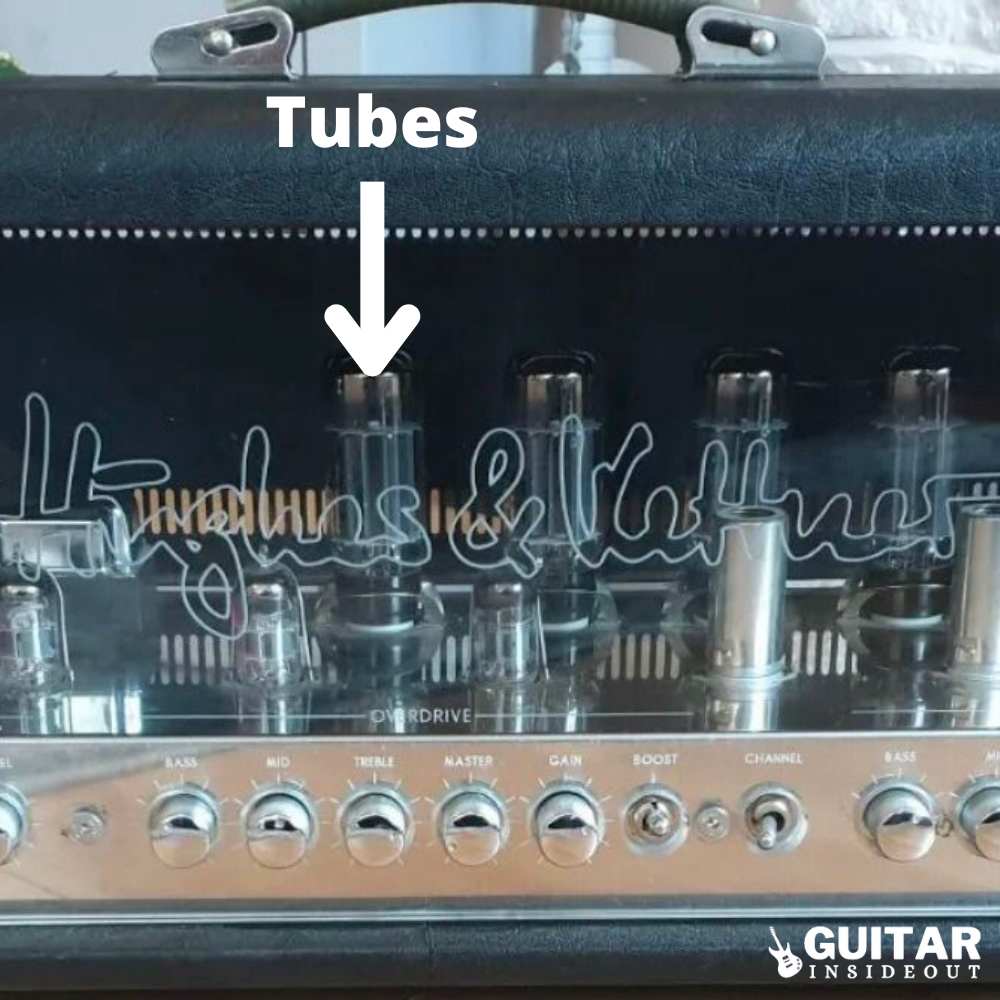
It’s the tubes that are used in the amp that set them apart from other amplifiers. The tubes (or valves) are small, tube shaped components (hence the name) that are enclosed in glass and filled with gases.
As the electric guitar’s signal passes through these tubes they amplify the sound. The tubes introduce harmonic distortions which create rich, organic tones that have become synonymous with rock, blues and many other genres.
It’s the “tube saturation” when tube amps are turned up that guitarists love so much.
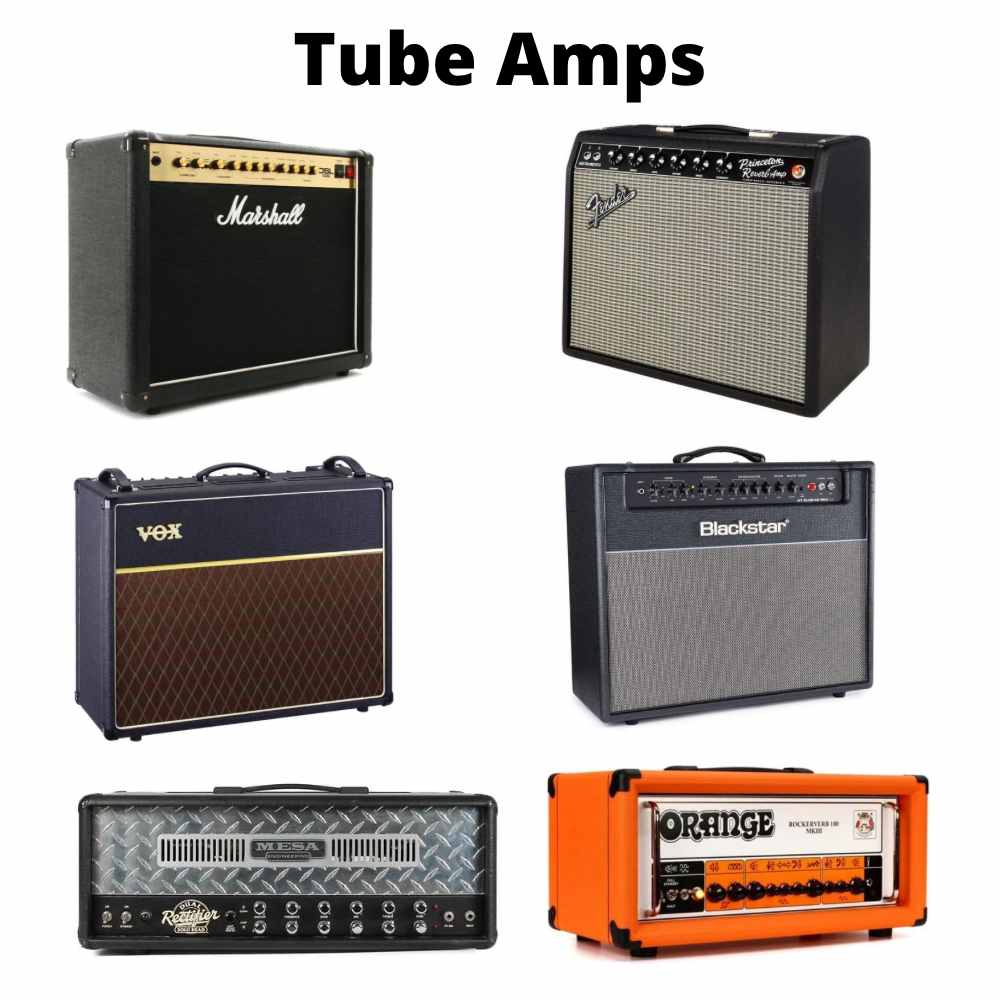
What Does a Tube Amp Sound Like?
Why tube amps are so popular is because they have a certain sound. Compared to solid state and digital amps the tubes produce a more “organic” tone.
It’s not all the easy to describe what that organic sound is but think of it as sort of warmer and more dynamic. It has a smooth and less harsh quality to it.
And the dynamics mean you can get a lot of variation and nuances in the volume and tone from the amp. The other types of amplifiers tend not to have the same range and subtlety.
Tube amps also create natural compression and harmonics. Natural compression refers to the way tube amps control the volume of the guitar signal whereas the harmonics are extra frequencies that get added to the signal.
The tubes in the amp limit the dynamic range as the guitar single passes through them and also produces the harmonic frequencies just mentioned.
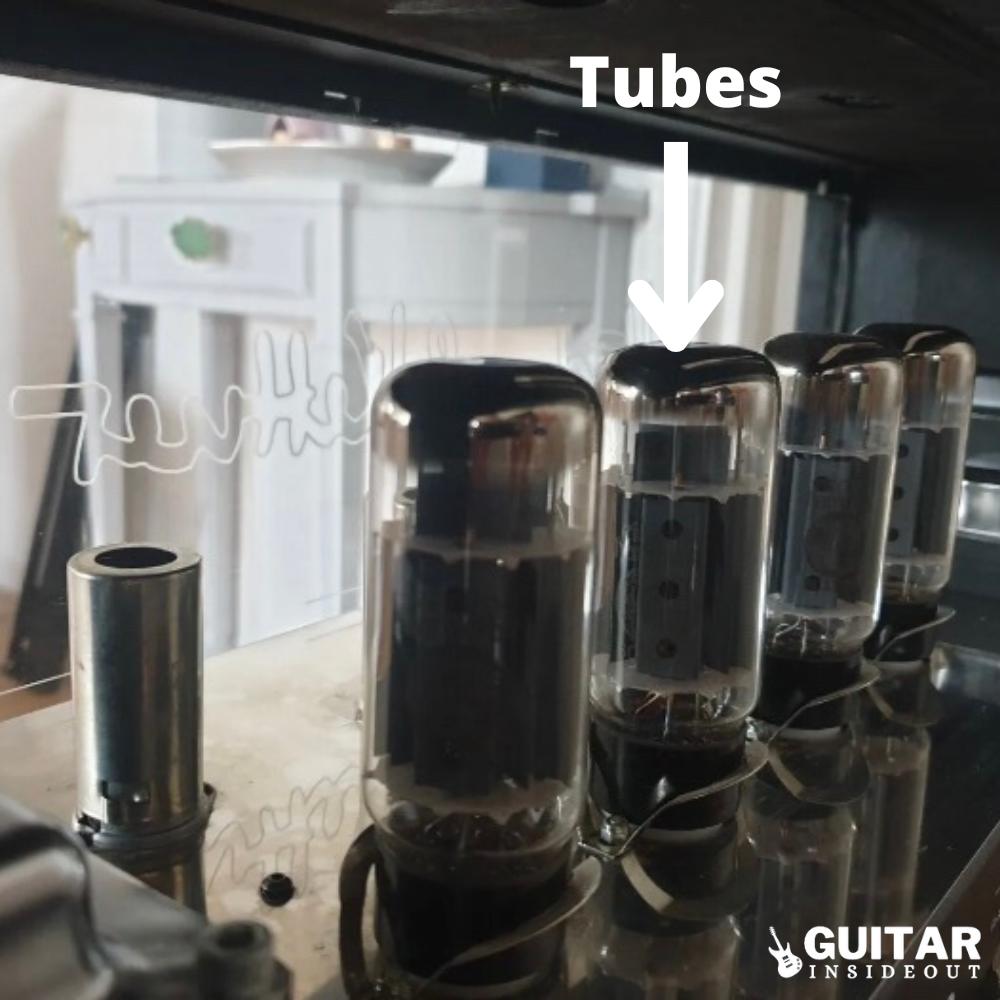
This makes the loud parts softer and the soft parts louder of the sound from the amp. On top of that the frequencies the tubes have added to the signal are multiples of the original notes played and help make the sound richer and more textured.
That may sound a little strange but it ends up making the tone smoother and more controlled. It’s all of the above combined that give tube amps their characteristic sound guitarists love.
How do Tube Amps Work?
You don’t need to fully understand how tube amps work to appreciate them. But it’s good to have an idea of what’s going on even on a basic level.
This is a very simple explanation of what happens:
- When you play your guitar the pickups convert the vibrations of the strings into an electrical signal. This is passed to the tube amp through your cable.
- That signal is then sent to the preamp section of the tube amp. The tubes in the preamp are responsible for the harmonics mentioned earlier. This contributes some of the tone and character of sound of the amp.
- After that the signal goes to the power amp section of the amp where the tubes boost the signal’s power and increases the volume. The signal can then drive the amp’s speakers. This process also adds some extra dynamics to the sound.
- The amplified signal then heads to the output transformer. This matches the impedance between the power tubes and the speakers.
- From there the signal is sent to the speakers which produce the sound you hear.
And that’s it. Obviously there’s a lot more that goes on but as a very simplified overview it gives you an idea of what’s going on when you play a guitar through a tube amp.
Why do Guitarists Prefer Tube Amps
Tube amps can be divisive. And I’m definitely not going to ignore the fact that some of the love for tube amps is down to marketing and following of trends.
When you hear lots of more experienced guitarists all saying that tube amps are far superior to the alternatives it’s easy to be influenced by that.
But there are some legitimate reasons for their popularity amongst guitarists.
Dynamics
This is a big one. Tubes amps respond to the way you play the guitar very dynamically. So how hard you hit the strings, different techniques etc. allow you to add nuance and feel to your playing.
Solid state and digital or modelling amps simply don’t have the same response. It’s all a bit more flat and one level.
Volume
Turn a tube amp up and it’ll sound better and better. The tubes begin to overdrive and you get that natural distortion that sounds so great.
A solid state amp doesn’t do this. The sound you get when quiet is the same as when it’s turned up.
Also tube amps are able to reach much higher volume. If you’re playing live then you need an amp that will be heard.
Pedals
Tube amps take pedals better than the other options. There are some solid state amps that play nicely with pedals. But most of them either don’t sound as good as tube amps when played with pedals or sound downright terrible with them.
Simplicity
I’m going to generalize a little here but a lot of tube amps are more straightforward than solid state or modellers. You don’t get the numerous onboard effects and settings that the others come with.
There are some exceptions – Mesa Boogies can be a nightmare to try and dial in and have a crazy amount of settings. But generally I think the likes of Fenders, Oranges and Vox’s and more simple to use.
You can just get on with playing.
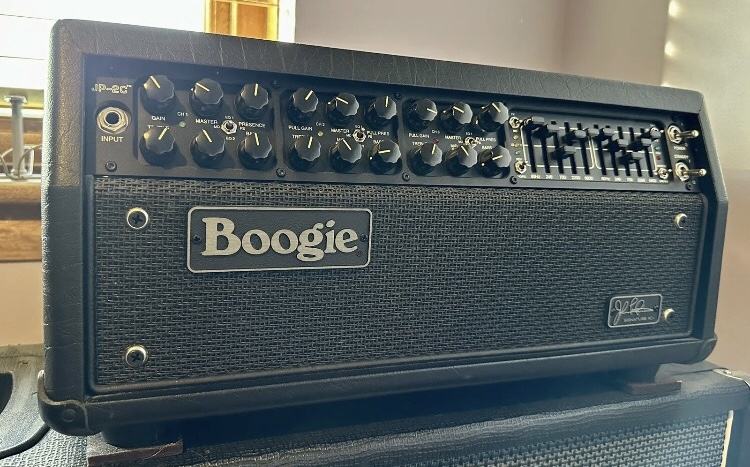
Changing Tubes
Different tubes make amps sound different. So you can switch and experiment with a variety tubes (e.g. 6L6, EL34, 6V6).
This allows guitarists to really fine-tune their amp’s tone. Something that isn’t really possible with other types of amps.
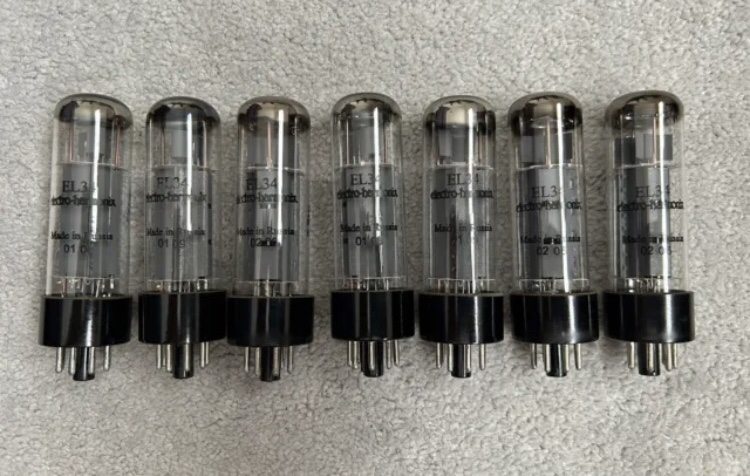
“Feel”
It sounds stupid but a lot of guitarists claim that tube amps have a certain intangible “feel” or responsiveness that cannot be replicated by other amplifier types. You will have to be the judge of whether that’s all in their head or genuinely the case.
But there’s no denying a lot of guitarists feel that way.
Advantages of Tube Amps
Tube amps have some big advantages over other amplifiers. Some of those advantages we’ve already touched on above when going through why guitarists favor tube amps. But there are many pro’s to choosing and using a tube amp.
Tone
Tube amps are known for their tone. It’s a rich and warm sound that is full and has a depth to it.
It has a certain organic quality to it that makes it feel more alive and responsive. It’s a bit like the difference between a live performance and a recorded one.
This is hard to replicate in other types of amps and one of the main reasons tube amps are so widely used.
Dynamic Responsiveness
As mentioned earlier tube amps offer a very dynamic response to guitarists touch. When you want to bring some variation and subtlety to your playing a tube amp lets you because of the way it reacts.
The responsiveness of the amp adds expression to your playing and give guitarists the ability to really get across what they want to say with their guitar and music.
Natural Overdrive and Distortion
When you turn a tube amp up and increase the volume it naturally produces distortion. The saturation and overdrive of the tubes is the type of distortion that many guitarists are looking for.
Compared to the distortion from other types of amps, that is quite often shrill and buzzy, a tube amps distortion is thick and warm.
Versatility with Pedals
Effects pedals generally work very well with tube amps. Especially distortion and overdrive pedals which are notorious for not sounding good when played with solid state amps.
Essentially the way the tubes and effects pedals interact is like a match made in heaven! So if you’re a guitarist who uses a lot of pedals or likes to experiment with different tones then a tube amp is usually the better choice.
In fact there are many tube amps considered to be ‘pedal platforms’ as they work so well with most pedals.
Sustain
Tube amps naturally produce compression and sustain. They do this more so than solid state amps, for example.
Guitarists generally prefer having more sustain when playing. Especially for certain styles and genres, and so a tube amp and the sustain it produces will be preferable.
Distinct Tones
Tube amps tend to have more of a ‘sound’ associated with them. For example if you wanted a sparkling clean tone then you would likely go for a Fender tube amp – something like a Princeton Reverb or Deluxe Reverb. If you wanted a very high gain amp then something like a Peavey 6506 or Mesa Boogie Dual Rectifer would be a good fit.
These amps are designed and built with a certain type of sound in mind. It’s not that other types of amps don’t have specific sounds or tones. It’s simply that tube amps are more synonymous with those sounds.
Nostalgia and Vintage
You could argue this isn’t a positive at all but the vintage charm of tube amps holds a nostalgic appeal for many guitarists. Getting an amp that is connected to a certain period in music history or a certain artist has an appeal that digital alternatives can’t offer.
Disadvantages of Tube Amps
While tube amps have many benefits they also come with a few drawbacks. It’s worth keeping all of these in mind when consider whether a tube amp is the right choice for your needs.
Weight and Size
Tube amps tend to be heavier and bulkier compared to their solid-state counterparts. If you’re a gigging musician then transporting a tube amp can be very difficult.
Larger combo tube amps like Vox AC30’s and some Mesa Boogies are extremely heavy and an absolute nightmare to move around. Lots of guitarists get back problems not from the weight of their guitar but from moving their amp!
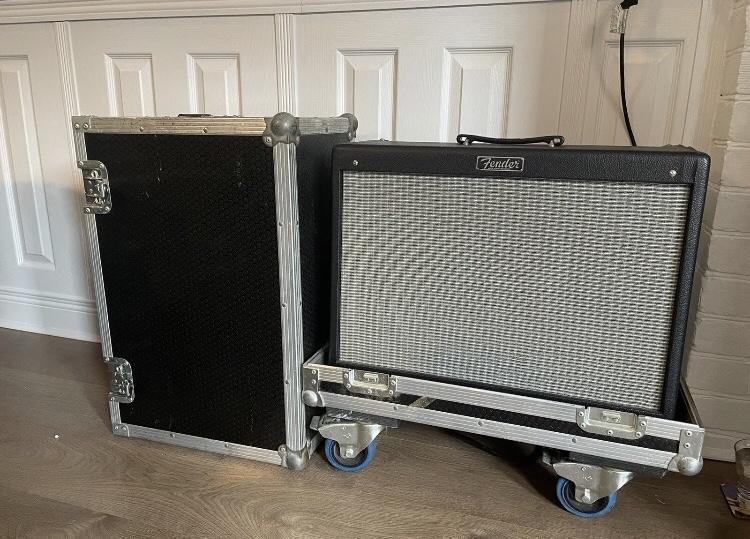
Maintenance and Fragility
Tube amps usually require more maintenance than solid state amps. The vacuum tubes have a limited lifespan and will need to be replaced at some point, which makes them more expensive. See this guide for how long the tubes last.
The tubes are also delicate and are easily damaged from something as simple as transporting or knocking the amp. So you have to be more careful with them compared to other amps.
Higher Cost
Tube amps generally cost more than solid-state amplifiers. The parts used like the tubes, transformer and other components contribute to the greater cost.
So when starting out or if funds are tight then solid state and modelling options are often better choices.
Warm-up Time
Unlike solid state amps that power up instantly tube amps can require a warm-up time. This is to let the tubes reach their optimal operating condition and protect the capacitors.
The warm-up period can vary but typically lasts a minute or so before the amp is ready for use. Not a huge problem but it’s a little bit annoying you can’t simply switch your amp on and start playing.
For more information follow this guide on how to turn on a tube amp the right way.
Limited Versatility at Low Volumes
In order to really get the characteristic sound a tube amp produces you need to push the volume. Playing most tube amps at low volume won’t give you that same tone they are known for.
You can use an attenuator and some tube amps come with built in power scaling now that helps to achieve that sound at low levels. But generally solid state amps are better at getting decent tones at low volumes.
It’s why you will see a lot of advice is to avoid tube amps unless you can turn them up. So if you’re only looking to practice at home or in your bedroom a tube amp might not be the right type of amp for you.
Lifespan of Tubes
The vacuum tubes in tube amps have a lifespan, which is usually measured in thousands of hours. So they will eventually wear out and need to be replaced.
In some amps this can be tricky and if you don’t know what you’re doing you might not want to attempt to replace them yourself. Solid state and modelling amps don’t have any parts that need replacing so are simpler in that regard.
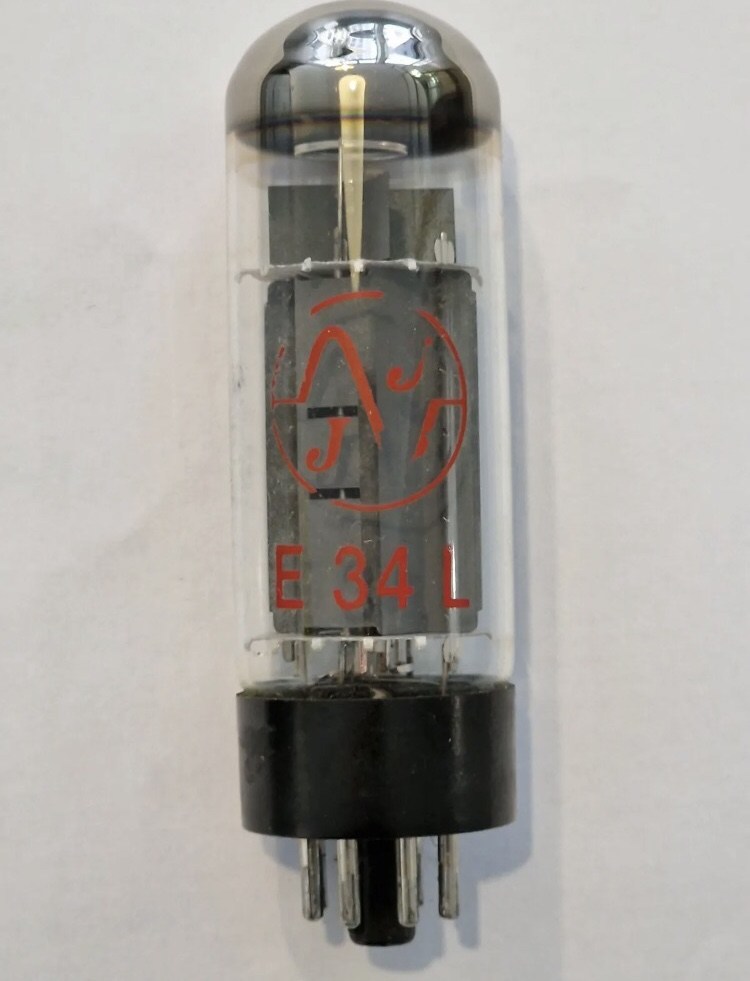
Power Consumption
Not the most important drawback but still worth considering. Tube amps tend to consume more power than solid-state amps.
This can mean they raise your electricity bills, especially if you’re using them extensively in rehearsals or performances.
Tube Amps vs Solid State and Modelling Amps
Tube amps biggest competitor, if you can call them that, are solid state amps. They’re the two main types of amps that are most popular amongst guitarists.
So how they compare and what they’re positives and negatives are is important when choosing between the two:
Sound and Tone
Tube amps generally are regarded as having a better tone than solid state or modelling amps. Whether you believe tube amps to be better or not what’s undeniable is the sound and tone they produce has been extremely influential. And pretty much all modelling amps are based on the sound of tubes amps.
But if you want to have lots of different options in one amp then a modeller will be better. For example a Fender tube amp, something like a Princeton, will do a great clean tone. But it’s never going to sound like a high gain amp unless you put an expensive pedal in front of it.
But while a modelling amp may not sound as good it will allow you to switch readily between high gain and clean, and everything in between.
Dynamic Response
Tube amps really excel in dynamic responsiveness. A players touch can really change the tone and feel of what they’re playing.
Hit the strings harder and you’ll get more distortion and break up. You get a lot more nuance in the volume and expression.
A solid state amp doesn’t really have that same sensitivity though. They tend not to compress in the same way and so the sound is far less dynamic.
In some situations this might be preferable. But for the most part it’s that dynamic sound and feel of the tube amp that is what guitarists prefer.
It is worth mentioning that the difference in responsiveness between tube and solid state amps has improved as the technology has got better. Many modern solid state amps now use various digital technologies that aim to replicate the dynamic response of tube amps.
Overdrive
When it comes to natural overdrive and distortion tube amps are the clear winner. When you turn a tube amp up and get the tubes cooking it’s like nothing else.
Solid state amps and modelling amps can do a decent job of simulating that distortion but never quite match the organic character of tube amps.
Maintenance and Reliability
Solid state amps are usually a lot more reliable and need much less maintenance. Tube amps aren’t these fragile things that have to be constantly wrapped in cottonwool.
But they are more susceptible to tubes breaking or going wrong, plus those tubes need replacing at times. As solid state amps have fewer moving parts they tend to have less problems.
But any piece of electrical equipment can go wrong or develop problems. And one area where tubes amps win is their longevity.
Solid state and modelling amps generally use software and hardware. When that goes wrong 10 years later – what do you do?
Most companies stop support for products after a few years. You only have to look at earlier models of something like an iPhone to see how they get ignored and eventually have zero support.
Tube amps don’t have this problem. A guitar amp tech will be able to fix most tube amp issues. They’ve been around for so many decades and aren’t going anywhere soon, so you won’t struggle to find someone who can fix your tube amp if it stops working.
But the same technician won’t be able to fix many problems with out of date solid state and modelling amps. Because the issues will often be software and hardware related that is very specific. And not something an amp tech will know about.
So something worth considering.
Portability and Weight
Tube amps can be ludicrously heavy. Solid state amps aren’t exactly featherweight but they are, on the whole, lighter and so easier to move and transport.
How much of this is an issue depends on how much you move your amp. If you’re gigging regularly then transporting a very heavy tube amp can become a problem.
Cost
The majority of tube amps are more expensive than solid state and modelling amps. It’s down to the way they’re constructed and the parts used to make them.
They might be worth the cost but if you’re on a tighter budget or new to playing guitar then you may find a more affordable solid state amp a better fit.
Versatility
Tube amps can be versatile. But as modelling amps have a huge range of sounds, amp models and effects all in one unit they’re hard to beat.
If you’re only looking for one sound or are happy to use pedals to get different tones then a tube amp will be fine. But if you really need a lot of various sounds then a modelling amp will probably be better.
Tube Amps Vs Amp Sims
As technology has continued to advance digital solutions like amp simulators (amp sims) have become increasingly popular among guitarists. They are similar to modelling amps but played through software on your computer.
Here’s how they compare to traditional tube amps:
- Sound: Amp sims, like modelling amps, aim to replicate the sound of various amplifiers digitally. While amp sims have made big strides in emulating tube amps some guitarists still argue they don’t have the same responsiveness of a tube amp.
- Convenience: There’s no doubt amp sims are more convenient. You can run then on any computer or mobile device that has the necessary software. So you can take a huge range of amp sounds effects with you on the go in a highly portable way. Tube amps are obviously a lot larger and heavier.
- Versatility: Amp sims offer you a vast library of amp models and effects in a single software package. This means you can easily and quickly switch between different amplifier types, cabinet simulations, effects etc. Tube amps don’t have this same versatility and might need pedals to achieve the same range of sounds.
- Recording: Amp sims have become a go-to solution for recording and studio work. You get a consistent tone that can be reproduced simply which makes them perfect for getting studio quality recordings. Tune amps are still used for recording too they just require a bit more effort than amp sims.
- Price: Amp sims are often more affordable than high end tube amps. Some amp sims and the software and hardware needed to use them can be fairly pricey they are usually less expensive than the top tube amps. But then the more affordable tube amps can still be very impressive. You don’t have to spend thousands to get a good amp.
- Playing Live: tube amps are still the choice for most guitarists. More and more famous bands and artists are staring to use modelling solutions but you’re still far more likely to see regular amps at live gigs. Having the physical presence of a tube amp on stage and being able to adjust the controls is going to feel more comfortable for most guitarists. But amps sims have their place and if you’ve not got a lot of space they can be useful.
It wouldn’t be a huge shock to see amp sims and similar alternatives to physical amps becoming more popular over time.
Do Tube Amps Need a lot of Maintenance
Tube amps don’t need a whole lot of maintenance. But they do need some to keep the performing at their best.
Here’s what you need to know about maintaining a tube amp:
- Replacing Tube: the most common maintenance task for tube amps is replacing the tubes. It’s a good idea to regularly inspect the tubes for signs of wear. Things like flickering, unusual noises or a decrease in output volume are all signs they probably need changing.
- Biasing: this is where you set the right voltage for the tubes. This is key for the tubes to work at their best and last as long as possible. Improper biasing can result in distorted sound, premature tube wear or even damage to the amp. To maintain the amp’s performance and prolong the life of the tubes it’s essential to have the bias checked and adjusted (if needed) by a qualified technician periodically.
- Cleaning and Dusting: Regularly clean and dust your tube amp to keep it free from debris and maintain good ventilation. Dust accumulating can affect the amp’s cooling efficiency and may lead to some components wearing out faster than they would have.
- Periodic Servicing: whilst it’s not a requirement you might want to consider having your tube amp serviced by a qualified technician at regular intervals, especially if you use it frequently. A professional inspection and maintenance check can identify potential issues and help to keep your amp performing optimally.
While tube amps do require more maintenance than solid state amplifiers if you care for them properly then they should keep running smoothly without any major issues.
Care and Maintenance Tips
These tips will help prolong your tube amps life span and keep it in its best shape.
Regular Tube Inspection
Check the tubes regularly for any signs of wear. Replace tubes as needed to maintain consistent tone and prevent potential damage to the amp.
Bias Adjustment
Biasing the tubes is a big part of maintaining the amp and guaranteeing it works properly. But it’s often a task for a qualified guitar technician. So if you’re not confident or don’t know how to bias the tubes yourself find someone who does know how.
Proper Power Down
Always power down your tube amp properly. Turn off the standby switch first (if your amp has one), then the power switch. After playing allow the amp to cool down before moving or covering it.
Avoid Frequent Power Cycling
While it’s essential to turn off your amp after use, try to avoid frequent power cycles as this can cause stress on the tubes. Let the amp warm up and cool down naturally.
Keep It Clear
Regularly clean the outside of your amp to remove dust and dirt. Use a soft, dry cloth to wipe the surface gently. Avoid using abrasive cleaners or water as they can damage the amp’s finish.
Proper Ventilation
Ventilation is important to let the heat dissipate from your amp. Avoid placing the amp in enclosed spaces or covering it with anything that could restrict airflow.
Handle with Care
When transporting or moving your amp hand it with care. Secure the tubes with appropriate padding or tube shields to prevent them from breaking during transit.
Speaker Connections
Inspect the speaker connections from time to time and check they are secure and free from loose wires. Loose connections will cause unwanted noise.
Maintain a Stable Environment
Humidity and extreme temperatures can really mess with your amp. So try to keep it in a stable environment if possible.
Consult the Manual
When in doubt consult the amps manual for any specific maintenance instructions. Different amps will have different ways to doing things.
Do I Need a Tube Amp?
Tune amps definitely have a certain allure. And when you see so many other guitarists talking them up it’s hard not to feel like you’re missing out or need one.
But that doesn’t mean they’re necessarily right for you. Here’s a few factors to consider before deciding to get a tube amp:
Playing Style
A tube amp might be a good fit for the style of music you like to play. But it might not.
The natural breakup of a tube amp is perfect for rock and blues. But for a pristine clean sound then some solid state amps are actually better, especially if you need a lot of clean headroom.
The Roland JC-120 is a classic example of top artists needing that amazing clean tone and going for a solid state amp ahead of a tube one.
So while a tube amp may seem like the best option it isn’t always.
Volume
If you’re a beginner or only play at home/in your bedroom then a tube amp may not be practical. Tube amps generally need to be turned up quite loud to sound their best which can be difficult if you’re playing in a small space or have neighbors you don’t want to annoy.
Solid state and modelling amps are much easier to use at lower volume.
But not all tube amps are ill suited to low volume. I use an Orange Rocker 15 to play at home and it has built in power scaling.
This means I can bring the watts down from 15 to 7, 1 or 0.5. This massively reduces the volume and makes playing at low volume much easier.
I’ve also written a guide for the best tube amps for playing at home which is worth checking out if you’re interested in getting one.
For playing live and at gigs a tube amp will be much more appropriate. And in fact is the norm. In that case you’re going to need to think more about how much volume you need and what size of venue you’re playing.
Budget
If you’re not looking to invest too much then a tube amp probably isn’t for you. Not all of them are expensive but for the most part they cost more than solid state and modelling amps.
Musical instruments and gear generally isn’t cheap. But if you’ve only just started learning then it’s understandable you wouldn’t want to spend big on an amp.
Tube amps tend to be the type of amp you upgrade to as you get better and know you’re going to keep on playing. Basically once you’re hooked!
So if you’ve got a tight budget or are in the beginner stages of learning then a small solid state amp is going to be better than a tube amp.
Size
You can get some very small tube amps – Fender Champs, Supro 1605R, some of the lunchbox heads like the Orange Micro Terror – but a lot of tube amps are larger. Even small wattage combos aren’t exactly tiny.
And to be fair the solid state options are similar. They are at least lighter though.
If space is a real issue then the desktop and battery powered amps might be worth looking at. Something like the Spark Go, Yamaha THR10 or BOSS Katana Mini can fit comfortably on your desk or shelf and be moved anywhere with ease.

And of course amp sims are perfect in this situation. Almost everyone had a computer or laptop and so all you would need is a pair of half decent speakers or studio monitors.
Maintenance
As already mentioned earlier tube amps can need a bit of maintenance. The tubes need replacing from time to time and they can break.
It wouldn’t be fair to call tube amps unreliable. Some tube amps will last for decades without ever having any issues.
But solid state amps are considered to be more reliable and need less ‘upkeep’. If you’re worried about that and having to deal with an amp that needs a little maintenance then choosing a solid state or modeller may make more sense.
Future Growth
Think about what your goals are. Do you see yourself getting to the stage of playing live, joining a band etc. Or are you content to only play at home.
If you’ve got ambitions to go further as a guitarist then a better amp will be on the cards at some point. But if you’re only noodling around in your bedroom then amp sims or a small solid state will probably be good enough.
Choosing the Right Tube Amp for you
If you do decide to get a tube amp then you should take some time to consider what exactly it is what you from it. Consider your style and what sort of music you will be playing.
Here are some essential aspects to keep in mind when choosing your ideal tube amp:
Tone
Think about what sort of tone you want. If it’s high gain then something like a Mesa Boogie, Peavey, certain Marshall’s etc. If it’s warm and organic tones then a classic Fender or Vox might be an excellent fit.
Wattage and Output Power
The wattage and power of your amp will depending on what you need from it. Lower-wattage amps (e.g., 5 to 15 watts) are better suited for home practice, studio recording and playing smaller venues. Higher-wattage amps (e.g., 30 to 100 watts) are going to be very loud and so will only be appropriate for large stages and gigs.
Single-Channel vs. Multi-Channel
A single channel amp will be simpler and let you get all your tone and expression from your guitars volume control. A multi channel amp will give you greater versatility though and suit certain styles of music better.
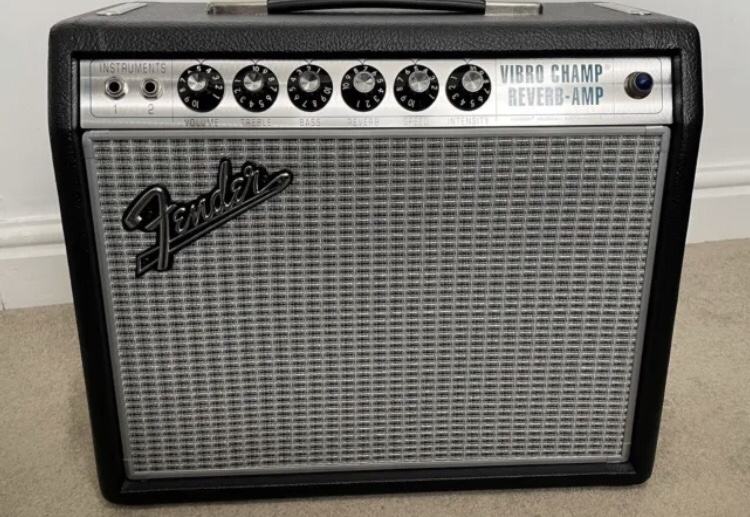
Pedal-Friendly
If you use a lot of effects pedals then an amp that is known to be a good pedal platform with a solid effects loop is what you will want. If pedals aren’t your thing then you can focus on more important features.
Reverb and Effects
Think about whether you need built-in reverb and other effects. Some tube amps come with onboard spring reverb, tremolo and more effects, which will save you from relying on pedals.
Portability and Size
If you’re travelling to gigs and need to move your amp often then a lighter choice might be preferable, if possible. But a larger amp will usually be louder and have more headroom. So it can be difficult to find the right balance.
Brand and Reputation
Do some research on the reputation and reviews of different amp brands. Well know manufacturers with a long history of producing quality tube amps are often a safer bet for a reliable choice.
Try Before You Buy
Whenever possible it’s always best to try out different amps in person. The best way to determine if an amp suits your style is to play it and listen to how it sounds firsthand.
Top Tube Amp Brands
There are a few very well known brands that you can rely on for high quality amplifiers. These are just some of the top tube amp brands that
Fender
One of the legendary names in the guitar world. Fender tube amps have set the bar very high when it comes to clean tones. The Deluxe Reverb and Twin Reverb are iconic amps and seen the world over in studios and on stage.
Marshall
Alongside Fender, Marshall is the other huge brand of amplifiers that are known worldwide. Marshall is more synonymous with rock music and their classic tube amps like the Marshall Plexi and JCM800 have defined the sound of rock and metal for decades.
With their powerful overdrive and distinctive British sound Marshall tube amps are the choice for high gain crunch and distortion.
Vox
Another British amp maker, Vox really came to prominence during the British Invasion in the 1960’s. With bands like The Beatles using Vox amps it’s no surprise they become so famous.
The AC30 and it’s little brother the AC15 are amongst their ironic lineup and known for chimey cleans, jangley crunch and overdrive. They’re seen used by a wide range of artists and bands, with rock, pop and alternative just some of the genres that make use of Vox amps.
Mesa Boogie
Mesa Boogie may have a strange sounding name but don’t let that fool you. Their amplifiers have been a huge part of modern rock and metal, with the likes of the Dual and Triple Rectifiers some of the most sought after amps for high gain.
Mesa Boogie made build quality and innovation a key part of their philosophy and it has made for extremely high quality guitar amplifiers.
Orange
Yet another British amp maker (we’re seeing a bit of a trend forming!). Orange amps are known for their distinctive orange tolex but more importantly for their tone. The very thick distortion their amps are known for has become increasingly popular, thanks to the likes of the Rockerverb and AD series.
On top of that it’s Orange who kick started the lunchbox style of amps that have really taken off. The Orange Tiny Terror was the first lunchbox amp head to really catch on and Orange followed that with other hugely successful amp heads like the Dark and Micro Terror.
Orange tube amps deliver a blend of vintage warmth and modern punch. This had made them a favorite among guitarists in a whole variety of genres.
These are just a few of the major tube amp brands. There are so many more but the 5 or so listed here is a good place to begin looking if you’re not familiar with tube amps.
Best Tube Amps
It’s impossible to go through all the options for buying a tube amp. There are so many brands, types of amps, various prices etc.
But these few are some of the best tube amps you can buy on the market right now:
Cleans
If you want a clean tone then it’s got to be Fender. The ’65 Deluxe Reverb is a classic tube amp loved by guitarists for its warm cleans and lush reverb. If that’s too big and powerful then the Princeton Reverb is a smaller 12 or 10″ amp that works well at lower volumes. Or you could try the tiny and classic Champ – a portable and space saving little 5 watt amp with an 8″ speaker.

High Gain
The Marshall DSL series offers that classic Marshall overdrive in a variety of wattage options. The DSL40CR is the more powerful option but the DSL1 and DSL5 are great bedroom amps.

If you’re playing modern metal or rock then a Mesa Boogie Dual Rectifier is as good as it gets. If you need something a little more manageable then the Mini Rectifier is still massive sounding but at 25 watts can be tamed.
For a different flavor the Orange Rockerverb 50 or 100 is a beast of an amp that could do pretty much everything. Most Orange tube amps are worth checking out, with my personal favorites the Rocker 15/Rocker Terror 15 and AD30.

Low Volume
The built in power scaling on the Orange Rocker 15 and Marshall DSL’s make them good options for playing at home. Blackstar’s range of HT amps like the HT-1R and HT-5R are also excellent tube amps that can be played at lower volume.
Avoid single channel amps that need to be turned up loud. If you’re only interests in cleans you could get away with a single channel Fender but if you want natural breakup and overdrive it will be far too loud to use at home.
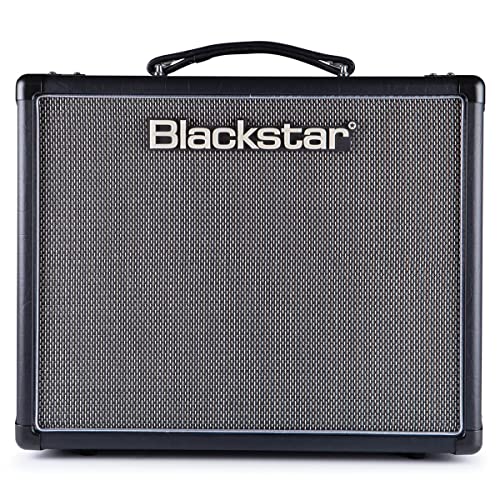
Those are just a few very quick suggestions. But you should do lots of your own research before deciding on a tube amp.
Tube Amp Terminology
All of the information here can be daunting. Trying to understand all the terms and jargon that the world of guitars and amps has can be tough for those new to it.
With that in mind here’s some of the key tube amp terms it’s worth knowing and what they mean:
Vacuum Tubes (Valves)
The vacuum tubes, commonly referred to as “valves”, are responsible for amplifying the electrical signal from the guitar and producing the tube amp tone. The most common types of tubes used in guitar amplifiers are preamp tubes (e.g., 12AX7, 12AT7) and power tubes (e.g., EL34, 6L6, EL84).
Preamp
The preamp section of a tube amp is responsible for shaping the tone. It usually includes the controls of the amp as well as the gain stages and volume controls.
Power Amp
The power amp section takes the preamp’s processed signal and amplifies it. This allows it to drive the speakers. Power amps are crucial for the overall volume and headroom of the amp.
Wattage
Wattage refers to the power output of a tube amp and is a useful indicator of how much volume it will produce. Higher wattage amps generally provide more headroom and clean volume while lower wattage amps tend to break up earlier and good at achieving power tube distortion at lower volume levels.
Single-Ended vs. Push-Pull
Tube amps can come as either single-ended or push-pull. Single-ended amps use a single power tube for amplification. This creates a more harmonic and touch sensitive tone. Push-pull amps use multiple power tubes working in pairs to increase power.
Class A vs. Class AB
Tube amps are categorised as Class A or Class AB based on their power amp design. Class A amps use a single power tube or multiple power tubes biased to operate in Class A mode. Class AB amps have power tubes biased to operate in both Class A and Class B modes.
Class A amps are less powerful and have less headroom but have a certain vintage sound that many guitarists prefer. They’re also more touch responsive. Class AB make a compromise between the sound quality and power and efficiency. This means their tubes last longer and they have more headroom but don’t sound quite as good nor have the same responsiveness.
Rectifier
The rectifier is converts alternating current (AC) from the wall outlet into direct current (DC) used to power the tubes. Tube amps can use different types of rectifiers like tube rectifiers or solid-state rectifiers.
Impedance
Impedance refers to the electrical resistance measured in ohms. You have to match the impedance of the amplifier with the impedance of the speaker cabinet to to make sure the post is transferred properly and doesn’t damage the amp or speakers.
Biasing
Biasing is when you adjust the power tubes idle current. It helps the tubes to last longer and sound at their best. It’s important to have the tubes biased to stop the tubes form wearing out prematurely and to keep the tone of the amp sounding it’s best.
Effects Loop
An effects loop lets you put effects pedals between the preamp and power amp of the amp. This provides a cleaner signal path for effects like reverb and delay and maintains the natural tone of the amp.
FAQ
Why are Tube Amps so Expensive
Tube amps tend to have a higher price tag compared to solid-state and modelling amps due to several factors:
- Vacuum Tube Production: Vacuum tubes are made by highway skilled craftsmen to very high standards. This increases the cost of the amp.
- Premium Components: Tube amps often use high-quality electrical components. They help the amp to sound and perform well but come at a high price.
- Handcrafted Construction: Many tube amps are made by hand rather than off a production line. This makes for a better amp with higher quality control but the extra cost is passed on to the consumer.
- Vintage Appeal and Tonal Quality: Guitarists prefer tube amps enough that the price can be increased and they will still pay it. The unique sound and justify the higher investment for many guitarists.
Do Tube Amps Require More Maintenance than Solid State Amps?
Yes, tube amps generally require more maintenance than solid state amps. The vacuum tubes have a limited lifespan so need replacing from time to time and should be bias adjusted to optimize performance. Solid state amps don’t have tubes so there is less maintenance.
Can I use Effects Pedals with a Tube Amp?
Absolutely. Tube amps work well with effects pedals, arguably more so than other types of amps. Most tube amps have effects loops as well which makes them even better suited for using pedals with.
Do Tube Amps Sound Better at Higher Volumes?
For the most part tube amps sound best when played at higher volume. The higher volume pushes the tubes into natural overdrive which is the sound associated with tube amps and what guitarists love.
There are some smaller tube amps with lower wattage that will sound good at lower volume though. And built in attenuation or power scaling will also help tube amp sound better at low volume.
Can I Replace the Tubes in My Tube Amp Myself?
Yes, you can but replace the tubes yourself but you should know what you’re doing first. If you’ve never done it before and you’re not familiar with electronics and biasing procedures it’s probably best to get a qualified guitar tech to do it for you. If you make a mistake you could potentially damage your amp or even injure yourself.
Are Tube Amps Suitable for Bedroom Practice?
Yes, tube amps can be used for bedroom practice. You can either choose a very low wattage amp, something like a Fender Champ or Marshall DSL1, or a tube amp that has built in power scaling or attenuation. This will allowing you to dial down the volume while maintaining the amps tone and responsiveness.
Do Tube Amps Sound Better with Specific Genres of Music?
Tube amps are very versatile and are used in various music genres. Virtually every genre of music will have tube amps as part of it from rock and blues to country and jazz.
Why Do Tube Amps have a Warm Up Time?
Tube amps need a warm up time because the tubes need to reach their operating temperature to function optimally. Allowing the tubes to warm up before playing lets them get up to that temperature and they are then more likely to last longer and sound good.
Should you Turn Off a Tube Amp When Not in Use?
It’s usually a good idea to turn off a tube amp when it’s not being used to prevent any damage to the tubes. But if the amp has a standby mode or switch then you can use that to take short breaks whilst you’re playing.
Do Tube Amps Require a Break-in Period?
This is debatable and some guitarists will say yes and some will say no. On the yes side the claim is that a tube amp needs roughly 50-100 hours of playing time to be fully broken in.
Are there any Safety Precautions to Take When Working on a Tube Amp?
Yes, make sue that it is unplugged first and the capacitors are discharged so that you avoid electrical shocks. You should also have some understanding of electronics and how to properly work on them as well as the correct tools for doing so.